Scotch Macaskill's Wildlife Blog
IMPORTANT: Please note that from April 2009 this Blog's Web address changed as a result of a switch in the blogging platform we use. It's still an integral part of the Wildlife Pictures Online website and, we hope, will continue providing entertaining and enjoyable content in the form of wildlife images, news, views and information.
For the most recent posts, links, and other resources, please visit the new Wldlife Photography Blog.
|
Today's Picture: Lion Cubs at Play
January 4, 2009
|
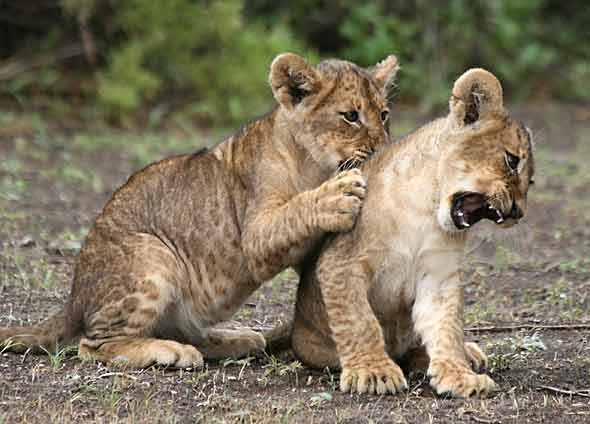
Photo Details: Lion cubs (Panthera leo) at play, testing their hunting and attack skills, Mashatu Game Reserve, Tuli Block, Botswana.
Camera: Canon EOS 400D (Canon Rebel XS 10.1MP); Lens: Canon 70-300 F4-5.6 IS USM; Focal Length: 300mm; Shutter speed: 1/500; Aperture: f5.6; ISO: 400.
|
Today's Picture: Hyena Snapping at Vulture
January 5, 2009
|
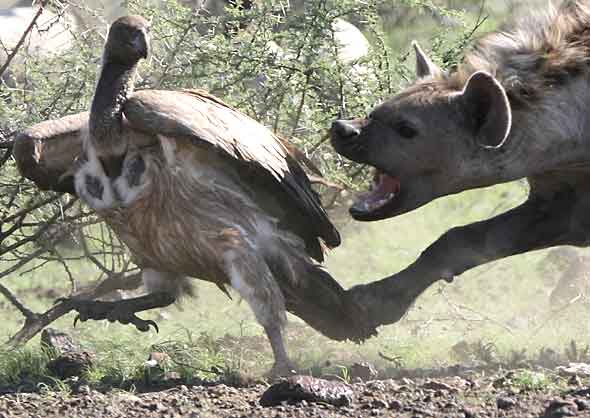
Photo Details: Spotted hyena (Crocuta crocuta) snaps at a vulture while chasing it from the carcass of a dead eland, Mashatu Game Reserve, Tuli Block, Botswana.
Camera: Canon EOS 400D (Canon Rebel XS 10.1MP); Lens: Canon EOS 80-200 F2.8 zoom; Focal Length: 200mm; Shutter speed: 1/800; Aperture: f5.6; ISO: 400.
|
Today's Picture: Lion Cub Reaching out to Male Lion
January 13, 2009
|
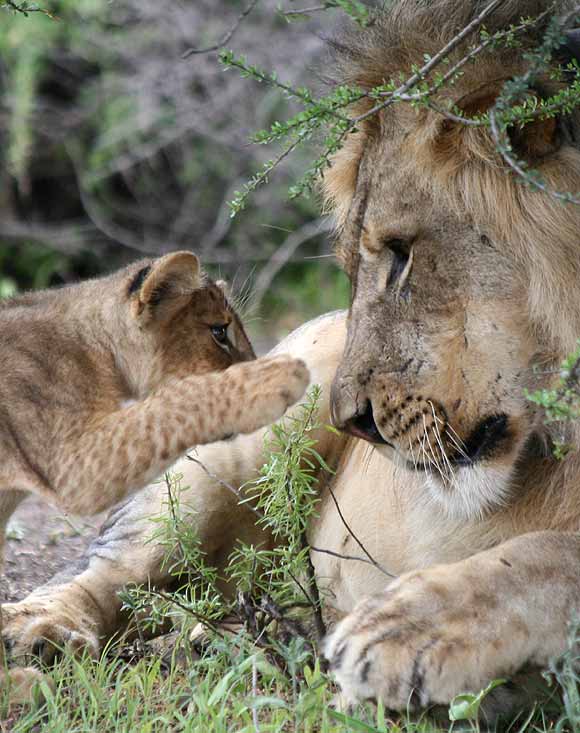
Photo Details: Lion cub (Panthera leo) reaches out tentatively to big male lion, then leans forward to touch the big guy's nose (below), Mashatu Game Reserve, Tuli Block, Botswana.
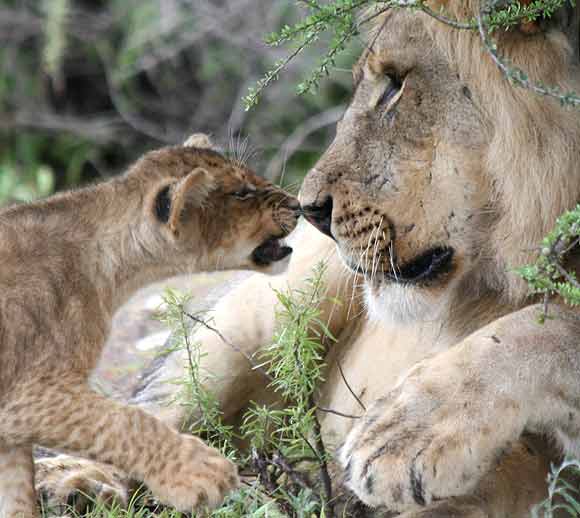
Additional Info: The cub and adult male appeared to be part of a pride comprising two similar-looking males (possibly brothers) and three females.
Of the females, two each had a pair of cubs, approximately the same age. So it's quite probable the cub was interacting with its father - or maybe its uncle. Later, in the space of a couple of days, we saw both adult males mating with the third female, which means it's possible her next litter could comprise cubs sired by two different fathers.
Camera: Canon EOS 400D (Canon Rebel XS 10.1MP); Lens: Canon 70-300 F4-5.6 IS USM; Focal Length: 300mm; Shutter speed: 1/200; Aperture: f5.6; ISO: 400.
|
Today's Picture: Lions Mating, Close-Up
January 18, 2009
|
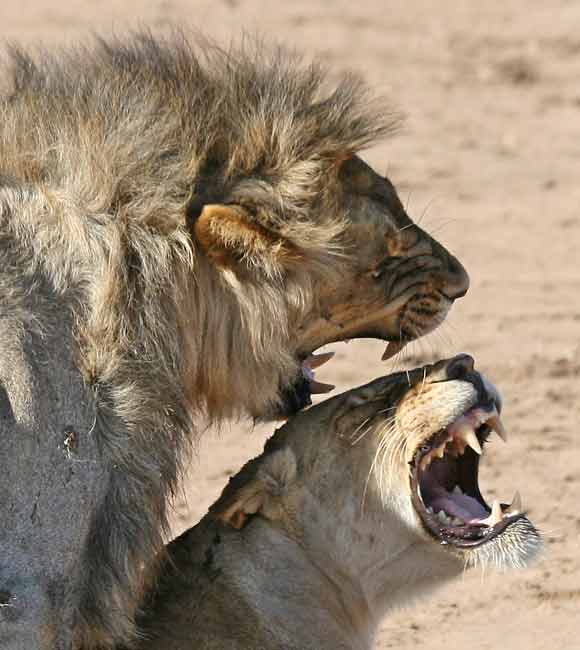
Photo Details: Lion pair (Panthera leo) mating, close-up view, Mashatu Game Reserve, Tuli Block, Botswana.
Camera: Canon EOS 400D (Canon Rebel XS 10.1MP); Lens: Canon 70-300 F4-5.6 IS USM; Focal Length: 110mm; Shutter speed: 1/1250; Aperture: f5.6; ISO: 400.
Additional Info: As mentioned in my previous blog post (13 Jan), we saw a lioness mating with two different males within the space of a couple of days while in Mashatu Game Reserve. The sexual behavior of lions, in the context of a pride's social structure, is quite fascinating and I have described what we saw in more detail with pictures and video - see Lions Mating article for more.
|
Kylie the Spotted Hyena
January 22, 2009
|
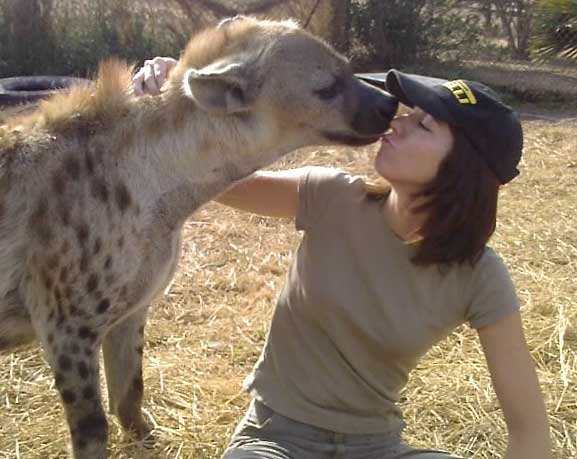 Photo Details: Kylie, a spotted hyena, and Sarah Carter, her carer, share an affectionate moment at the Bally Vaughan Sancturay in Zimbabwe.
Photo Details: Kylie, a spotted hyena, and Sarah Carter, her carer, share an affectionate moment at the Bally Vaughan Sancturay in Zimbabwe.
Kylie was rescued a year ago from a tiny enclosure on a game farm in Zimbabwe where all the animals faced starvation. Since then she has responded to the daily routine of plenty of food,
love and attention at the Sanctuay and has formed a strong bond with her carers.
It's humbling how she and her dedicated helpers not only cope, but retain a wonderful sense of humour under appalling conditions. As Sarah explains:
"We now rely totally on donations to keep the Sanctuary functional as out-of-control inflation, severe shortages and political upheaval take their toll on Zimbabwe. Many of you visit us frequently, some of you we have never met. All of you share our faith and hope for better times, and help to give our beloved animal family the love, care and dignity that they so deserve. Without you, we would not be here now."
To put the "out-of-control inflation" into perspective, Zimbabwe, a once-prosperous nation, introduced a new Z$50 billion note on 13 January. This was enough to buy three newspapers. Less than a week later, the Reserve Bank of Zimbabwe announced it was introducing a Z$100 trillion note!
|
Today's Picture: Bat-Eared Fox Cubs
January 22, 2009
|
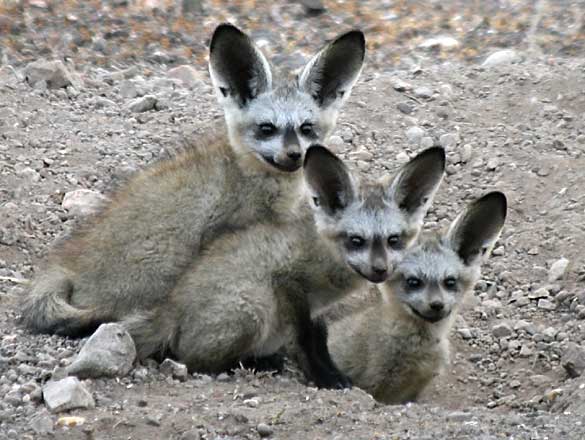
Photo Details: Three bat-eared fox cubs (Otocyon megalotis) watch inquisitively from the entrance to their burrow, ready to disappear at any sign of danger, Mashatu Game Reserve, Tuli Block, Botswana.
Camera: Canon EOS 400D (Canon Rebel XS 10.1MP); Lens: Canon 70-300 F4-5.6 IS USM; Focal Length: 300mm; Shutter speed: 1/320; Aperture: f5.6; ISO: 400.
Additional Info: Bat-eared foxes fall within the Canidae family, so are true dogs (I wonder why the young are called "cubs" and not "pups"?). Unlike other Canids such as jackals and wild dogs, bat-eared foxes derive about 80% of their food from insects, especially termites. Their speciality is to hunt for underground beetle larvae, which they locate by sound, using their huge ears.
Bat-eared foxes usually live in pairs and produce litters of one to five cubs that stay hidden in the burrow for the first three weeks. They start joining their parents on hunting trips when they're about 10 to 12 weeks old.
|
Today's Picture: African Wild Dog on the Move
January 29, 2009
|
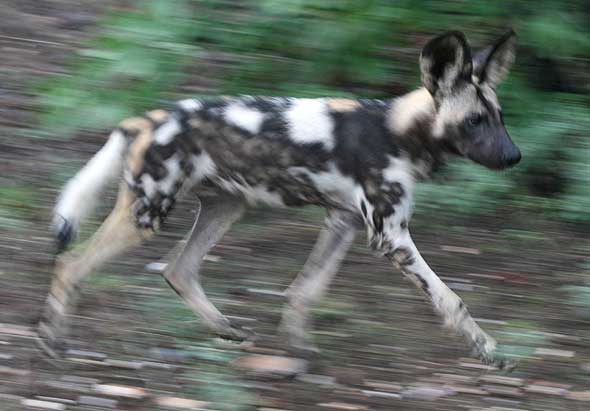
Photo Details: African wild dog (Lycaon pictus) moving at a half trot through wooded area, Mashatu Game Reserve, Tuli Block, Botswana.
Camera: Canon EOS 400D (Canon Rebel XS 10.1MP); Lens: Canon 70-300 F4-5.6 IS USM; Focal Length: 95mm; Shutter speed: 1/30; Aperture: f8; ISO: 400.
Additional Info: The wild dog was one of a pack of 23 we came across in a densely wooded area on a heavily overcast day. They were moving around randomly, this way and that, sometimes at a trot, making photography difficult. For the above shot, I opted for a slow shutter speed and tried panning the camera to blur the background and reduce background clutter.
Wild dogs were re-introduced to the Tuli area in November 2007 with the intention of establishing a viable pack of this endangered species within the Limpopo Valley region of eastern Botswana. The initial pack, comprising 18 dogs, was first held in an enclosure before being released in April 2008. When we saw them in late December, the pack consisted of 11 adults and 12 sub-adult pups.
Wild dogs are ruthlessly efficient hunters and this pack is no exception. In a single afternoon they were seen killing five impala in Mashatu Game Reserve. Fortunately the dogs are constantly on the move, covering vast distances, otherwise it's possible they could decimate the area's population of small antelope.
|
| |
| Back to top of page
|
|
Previous Entries
By Month
By Category
My Original Blog
2005 Entries
2004 Entries
2003 Entries
Who Am I?
Brief Bio
|






 Photo Details: Kylie, a spotted hyena, and Sarah Carter, her carer, share an affectionate moment at the Bally Vaughan Sancturay in Zimbabwe.
Photo Details: Kylie, a spotted hyena, and Sarah Carter, her carer, share an affectionate moment at the Bally Vaughan Sancturay in Zimbabwe.

